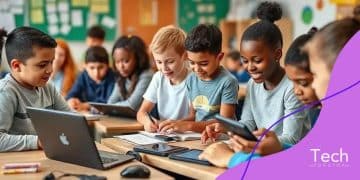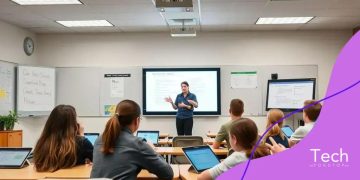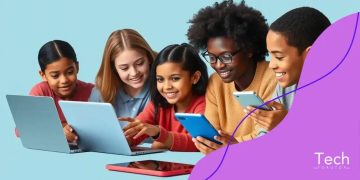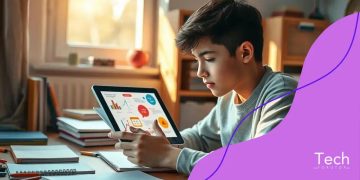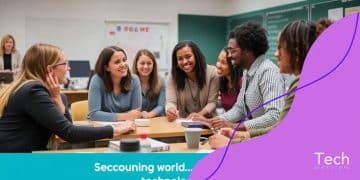Flipped classrooms: redefining homework and lectures
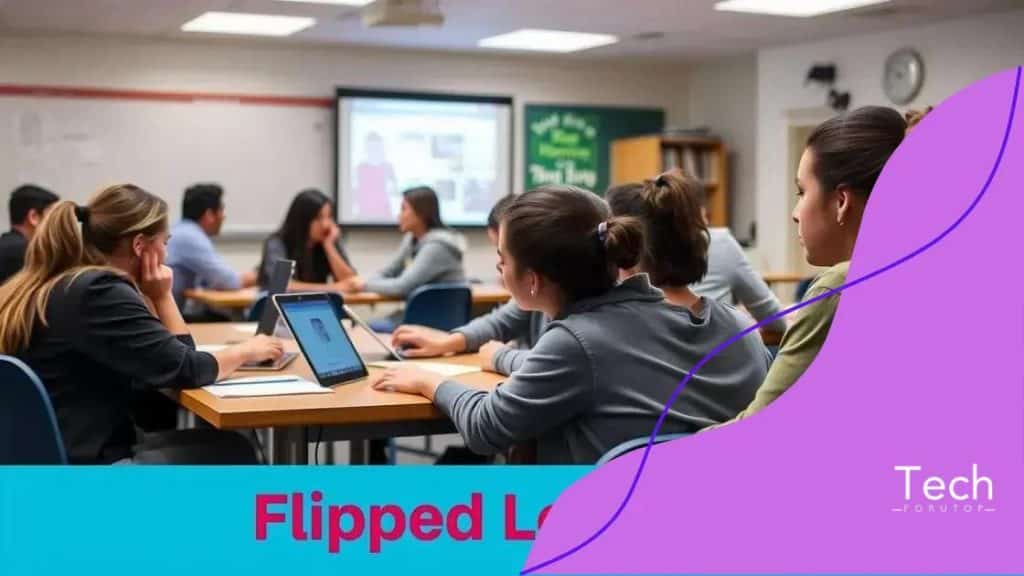
Flipped classrooms involve reversing traditional teaching methods by delivering content online before class, allowing for interactive, hands-on learning during classroom time, thus enhancing student engagement and personalized education.
Flipped classrooms are changing the way we think about learning. By reversing traditional environments, educators are finding new ways to engage students, making lessons more interactive and effective. Curious about how this model works? Let’s dive in!
What are flipped classrooms?
Flipped classrooms represent a revolutionary approach to education, shifting the way students interact with content. Instead of the traditional model where lectures occur in class and homework is done at home, flipped classrooms invert this process. In this model, students learn new material through videos or readings outside of class, allowing for deeper engagement during classroom time.
This innovative method fosters a more interactive environment. Teachers can focus on guiding students through practical applications and collaborative projects rather than lecturing. As a result, students become active participants in their own learning.
Key Characteristics of Flipped Classrooms
A flipped classroom is defined by several key traits:
- Students access pre-recorded lectures or reading materials at home.
- Class time is dedicated to activities that reinforce the material.
- Teachers facilitate discussions and collaborative projects during class.
This structure allows students to learn at their own pace, revisiting complex topics as needed without the time constraints of a traditional lecture. Additionally, it encourages self-directed learning, as students are responsible for their own educational journeys. The teacher’s role becomes more of a coach, guiding learners and providing support when necessary.
Technology in Flipped Classrooms
Technology plays a crucial role in flipped classrooms. Effective use of online platforms and resources enhances the learning experience. Educators can utilize tools like:
- Video hosting platforms for lecture sharing.
- Collaboration tools for group projects.
- Assessment apps to track student progress and understanding.
The availability of diverse resources enables personalized learning paths, catering to the unique needs of each student while facilitating a more engaged classroom atmosphere.
Benefits of flipped classrooms for students
Flipped classrooms offer numerous advantages that can greatly enhance student learning experiences. This innovative approach moves traditional lectures outside of the classroom and allows for more active participation during class time. With this method, students gain the ability to engage deeply with the material.
One main benefit is the ability for students to learn at their own pace. When lectures are recorded and made available online, learners can pause, rewind, or review the content as necessary. This flexibility supports diverse learning styles and enables students to grasp challenging concepts without the rush of a classroom setting.
Enhanced Engagement and Interaction
Another advantage of flipped classrooms is the increase in student engagement. By utilizing class time for discussions, group work, and hands-on activities, students can actively participate in their education. This model encourages collaboration and allows them to ask questions and receive immediate feedback.
- Students feel more involved in the learning process.
- Peer collaboration fosters communication skills.
- Real-time problem solving enhances critical thinking.
Additionally, teachers can better tailor their instruction to meet the needs of each student. Educators can assess students’ understanding during class activities, allowing them to provide targeted help when necessary. This personalized support is not only beneficial for struggling students but also helps advanced learners challenge themselves further.
Improved Academic Performance
Research has shown that students in flipped classrooms often experience improved academic performance. This can be attributed to the increased interaction and hands-on experiences that help reinforce learning. As students take more control over their education, their motivation and responsibility can also increase, leading to greater achievement.Flipped classrooms also promote better retention of information. When students are actively engaged with the material, they are more likely to remember what they learn and apply it in various contexts. Moreover, they develop essential skills that prepare them for future challenges.
How to implement flipped classrooms

Implementing flipped classrooms requires careful planning and a few key strategies. By following effective steps, educators can create a dynamic learning environment that maximizes student engagement and understanding. Start by selecting the right technology and resources to facilitate learning.
First, teachers need to choose tools for sharing materials, such as videos, readings, or podcasts. Educational platforms, like Google Classroom or Edmodo, can organize resources and foster communication between teachers and students. Having materials readily available is essential for a successful flipped classroom.
Creating Engaging Content
Next, focus on producing engaging and educational content. Teachers can create their own videos or curate high-quality resources that are easy to understand. Remember that the goal is to make the learning experience enjoyable and effective for students. Encourage creativity by using different formats and multimedia.
- Incorporate videos that explain concepts simply.
- Use interactive quizzes to reinforce knowledge.
- Share articles and blogs that promote critical thinking.
After establishing the resources, it’s important to communicate the flipped classroom model clearly to students and parents. Explain how it works, its benefits, and what is expected from everyone involved. Transparency helps in building trust and encouraging buy-in from students.
Designing Class Activities
Plan in-class activities that support learning and collaboration. The classroom should be a space for discussion, problem-solving, and practical application of concepts. Group projects, debates, and peer reviews can enrich the learning experience. Students should work together, sharing knowledge and ideas.
Furthermore, gather feedback from students to continuously improve the implementation process. Listening to student experiences helps identify what works well and what can be optimized. By being responsive to their needs, teachers can adjust methods, ensuring a better fit for the classroom environment.
Finally, begin with a small pilot of the flipped classroom model. This allows for adjustments before full-scale implementation. Monitoring the implementation will help in refining the approach over time.
Tools and technologies for flipped learning
Tools and technologies play a crucial role in making flipped classrooms effective. By using the right resources, educators can improve the learning experience for students and create a more engaging environment. Selecting the right technology can enhance both teaching and learning.
Video hosting platforms are essential for sharing educational content. Teachers can create their own lectures or use existing resources to provide students with easy access to learning material. YouTube, Vimeo, and educational platforms like Edpuzzle allow instructors to add interactivity to their videos. This interaction promotes retention and understanding of key concepts.
Collaboration Tools
In a flipped classroom, collaboration among students is vital. Using collaboration tools can encourage teamwork and enhance learning outcomes. Platforms such as Google Docs and Microsoft Teams facilitate group projects by allowing multiple students to work together in real-time. Additionally, these tools can store resources and enable peer feedback.
- Shared documents for collaborative writing.
- Discussion boards for class communication.
- Platforms for project management to track progress.
Another important aspect of flipped learning is assessment technology. Educators can utilize tools like Kahoot! and Quizizz to create engaging quizzes that help reinforce knowledge. These platforms provide immediate feedback, allowing students to identify areas where they need improvement.
Learning Management Systems
A robust Learning Management System (LMS) is also beneficial in flipped classrooms. Popular LMS platforms like Moodle and Canvas allow teachers to organize course materials, manage assignments, and track student progress. These systems create a centralized location for all learning resources, making it easier for students to access materials whenever they need.
Moreover, integrating mobile learning apps can further enhance the flipped classroom experience. Apps like Nearpod and Flipgrid allow students to engage with content through interactive presentations and video discussions. These technologies support various learning styles and keep learners motivated.
By leveraging these tools and technologies, educators can successfully implement a flipped classroom model that fosters student engagement, collaboration, and mastery of content. Careful selection of resources is key to cultivating an effective learning environment.
Challenges in adopting flipped classrooms
Adopting flipped classrooms can bring several challenges that educators must navigate. While the benefits are significant, understanding and addressing these obstacles is crucial for a successful transition. One major challenge is the need for technology access.
Many students may not have reliable access to devices or high-speed internet at home, making it difficult for them to engage with online materials. This digital divide can lead to disparities in learning opportunities. Educators should consider alternatives, such as providing resources on school grounds or ensuring that all students have access to necessary technology.
Resistance to Change
Another challenge involves resistance to change from both students and teachers. Traditional teaching methods are deeply ingrained, and some individuals may feel uncomfortable with new approaches. Training sessions can help ease this transition by providing educators with the tools and confidence they need to implement a flipped classroom.
- Offer professional development for teachers.
- Involve students in the process to gain their buy-in.
- Communicate the benefits clearly to all stakeholders.
Moreover, educators often face time constraints. Creating engaging content and activities requires preparation outside of regular teaching hours. Teachers must balance their time effectively between planning, delivering lessons, and grading, which can be overwhelming.
Maintaining Student Engagement
Furthermore, maintaining student engagement can be difficult in a flipped classroom model. If students are not motivated to complete pre-class materials, the in-class experience may suffer. To combat this, teachers can use varying instructional strategies and interactive materials to keep students interested and accountable for their learning.
Assessment also becomes more complex in this model. Teachers need to create methods that evaluate both pre-class learning and in-class activities. Implementing formative assessments can help gauge student understanding and provide feedback without adding significant grades to their overall performance.
By recognizing these challenges, educators can develop strategies to overcome them. A thoughtful approach to implementing a flipped classroom can lead to a more engaged and effective learning environment.
FAQ – Frequently Asked Questions about Flipped Classrooms
What are the main benefits of flipped classrooms?
Flipped classrooms enhance student engagement, allow for personalized learning, and improve collaboration among students during class time.
What challenges do teachers face when implementing flipped classrooms?
Challenges include ensuring technology access for all students, overcoming resistance to change, and finding the time to create engaging content.
What tools can I use to support flipped learning?
Useful tools include video hosting platforms like YouTube, collaboration tools like Google Docs, and Learning Management Systems like Moodle.
How can I maintain student engagement in a flipped classroom?
To maintain engagement, vary instructional strategies, use interactive materials, and incorporate regular feedback to keep students motivated.
